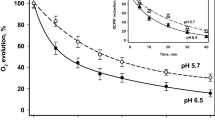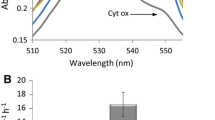Abstract
The O2-evolution deficient mutant (LF-1) of Scenedesmus obliquus inserts an unprocessed D1 protein into the thylakoid membrane and binds less than half the wild type (WT) level of Mn. LF-1 photosystem II (PS II) membrane fragments lack that part of the high-affinity Mn2+-binding site found in WT membranes which may be associated with histidine residues on the D1 protein (Seibert et al. 1989 Biochim Biophys Acta 974: 185–191). Hsu et al. (1987 Biochim Biophys Acta 890: 89–96) purport that the high-affinity site (characterized by competitive inhibition of DPC-supported DCIP photoreduction by μM concentrations of Mn2+) in Mn-extracted PS II membranes is also the binding site for Mn functional in O2 evolution. Proteases (papain, subtilisin, and carboxypeptidase A) can be used to regenerate the high-affinity Mn2+-binding site in LF-1 PS II membranes but not in thylakoids. Experiments with the histidine modifier, DEPC, suggest that the regenerated high-affinity Mn2+-binding sites produced by either subtilisin or carboxypeptidase A treatments were the same sites observed in WT membranes. However, none of the protease treatments produced LF-1 PS II membranes that could be photoactivated. Reassessment of the processing studies of Taylor et al. (1988 FEBS Lett 237: 229–233) lead us to believe that their procedure also does not result in substantial photoactivation of LF-1 PS II membranes. We conclude that (1) the unprocessed carboxyl end of the D1 protein in LF-1 is located on the lumenal side of the PS II membrane, (2) the unprocessed fragment physically obstructs or perturbs that part of the high-affinity Mn2+-binding site undetectable in LF-1, and (3) the D1 protein must be processed at the time of insertion into the membrane for normal O2-evolution function to result.
Similar content being viewed by others
Abbreviations
- Chl:
-
chlorophyll
- DCBQ:
-
2,6-dichloro-1,4-benzoquinone
- DCIP:
-
2,6-dichlorophenol indophenol
- DEPC:
-
diethylpryocarbonate
- DPC:
-
1,5-diphenylcarbazide
- HEPES:
-
4-(2-hydroxyethyl)-1-piperazine-ethanesulfonic acid
- LDS-PAGE:
-
lithium dodecylsulfate polyacrylamide gel electrophoresis
- LF-1:
-
a low-fluorescent mutant of Scenedesmus obliquus
- MES:
-
4-morpholineethanesulfonic acid
- PS II:
-
photosystem II
- PMSF:
-
phenylmethylsulfonyl fluoride
- RC:
-
photosystem II reaction center
- Tris:
-
tris(hydroxymethyl)aminomethane
- WT:
-
wild type
References
Abramowicz DA and Dismukes GC (1984) Manganese proteins isolated from spinach thylakoid membranes and their role in O2 evolution. II. A binuclear manganese-containing 34 kilodalton protein, a probable component of the water dehydrogenase enzyme. Biochim Biophys Acta 765: 318–328
Ambler RP (1967) Enzymic hydrolysis with carboxypeptidases. Methods Enzymol 11: 155–166
Amesz J (1983) The role of manganese in photosynthetic oxygen evolution. Biochim Biophys Acta 726: 1–12
Armstrong JMcD (1964) The molar extinction coefficient of 2,6-dichlorophenol indophenol. Biochim Biophys Acta 86: 194–197
Bishop NI (1971) Preparation and properties of mutants: Scenedesmus. Methods Enzymol 23: 130–143
Dismukes GC (1986) The metal centers of the photosynthetic oxygen-evolving complex. Photochem Photobiol 43: 99–115
Dismukes GC (1988) The spectroscopically derived structure of the manganese site for photosynthetic water oxidatization and a proposal for the protein-binding sites for calcium and manganese. Chemica Scripta 28A: 99–104
Diner BA, Ries DF, Cohen BN and Metz JG (1988) COOH-terminal processing of polypeptide D1 of the photosystem II reaction center of Scenedesmus obliquus is necessary for the assembly of the oxygen-evolving complex. J Biol Chem 263: 8972–8980
Hsu B-D, Lee J-Y and Pan R-L (1987) The high-affinity binding site for manganese on the oxidizing side of photosystem II. Biochim Biophys Acta 890: 89–96
Ikeuchi M, Koike H and Inoue Y (1988) Iodonation of D1 (herbicide binding protein) is coupled with photooxidation of 125I− associated with Cl−-binding site in photosystem-II water-oxidation system. Biochim Biophys Acta 932: 160–169
Kok B, Forbusch B and McGloin M (1970) Cooperation of charges in photosysnthetic O2 evolution—I. A linear four step mechanism. Photochem Photobiol 11: 457–475
Mattoo AK and Edelman M (1987) Intramembrane translocation and posttranslational palmitoylation of the chloroplast 32-kDa herbicide-binding protein. Proc Natl Acad Sci USA 84: 1497–1501
Metz JG and Bishop NI (1980) Identification of a chloroplast membrane polypeptide associated with the oxidizing side of photosystem II by the use of select low-fluorescent mutants of Scenedesmus. Biochem Biophys Res Commun. 94: 560–566
Metz JG and Seibert M (1984) Presence in photosystem II core complexes of a 34-kilodalton polypeptide required for water photolysis. Plant Physiol 76: 829–832
Metz JG, Wong J and Bishop NI (1980) Chances in electrophoretic mobility of a chloroplast membrane polypeptide associated with loss of the oxidizing side of photosystem II in low fluorescent mutants of Scenedesmus. FEBS Lett 114: 61–66
Metz JG, Bricker TM and Seibert M (1985) The azido [14C] atrazine photoaffinity technique labels a 34-kDa protein in Scenedesmus which functions on the oxidizing side of photosystem II. FEBS Lett 185: 191–196
Metz JG, Pakrasi HB, Seibert M and Arntzen CJ (1986) Evidence for dual function of the herbicide-binding D1 protein in photosystem. II. FEBS Lett 205: 269–274
Miles EW (1977) Modification of histidyl residues in proteins by diethylpyrocarbonate. Methods Enzymol 47: 431–442
Miyao M and Murata N (1984) Effect of urea on photosystem II particles. Evidence for an essential role of the 33 kilodalton polypeptide in photosynthetic oxygen evolution. Biochim Biophys Acta 765: 253–257
Nanba O and Satoh K (1987) Isolation of a photosystem II reaction center consisting of D-1 and D-2 polypeptides and cytochrome b−559. Proc Natl Acad Sci USA 84: 109–112
Ono T-A and Inoue Y (1983) Mn-preserving extraction of 33-, 24, and 16-kDa proteins from O2-evolving PS II particles by divalent salt-washing. FEBS Lett 164: 255–260
Ottensen M and Svendsen I (1970) The subtilisins. Methods Enzymol 19: 199–215
Rutherford AW, Seibert M and Metz JG (1988) Characterisation of the low-fluorescent (LF-1) mutant of Scenedesmus by EPR. Biochim Biophys Acta 932: 171–176
Seibert M, Cotton TM and Metz JG (1988) Surface-enhanced Raman scattering spectroscopy: probing the lumenal surface of photosystem II membranes for evidence of manganese. Biochim Biophys Acta 934: 235–246
Seibert M, Tamura N and Inoue Y (1989) Lack of photoactivation capacity in Scenedesmus obliquus LF-1 results from loss of half the high-affinity manganese-binding site. Relationship to the unprocessed D1 protein. Biochim Biophys Acta 974: 185–191
Smyth DG (1967) Techniques in enzymic hydrolysis. Methods Enzymol 11: 214–231
Takahashi M, Shiraishi T and Asada K (1988) COOH-terminal residues of D1 and the 44 kDa CPa-2 at spinach photosystem II core complex. FEBS Lett 240: 6–8
Tamura N and Cheniae GM (1986) Requirements for the photoligation of Mn2+ in PS II membranes and the expression of water-oxidizing activity of the polynuclear Mn-catalyst. FEBS Lett 200: 231–236
Tamura N and Cheniae GM (1987) Photoactivation of the water-oxidizing complex in photosystem II membranes depleted of Mn and extrinsic proteins. I. Biochemical and kinetic characterization. Biochim Biophys Acta 890: 179–194
Tamura N, Ikeuchi M and Inoue Y (1989) Assignment of histidine residues in D1 protein as possible ligands for functional manganese in photosynthetic water-oxidizing complex. Biochim Biophys Acta 973: 281–289
Taylor MA, Nixon PJ, Todd CM, Barber J and Bowyer JR (1988a) Characterisation of the D1 protein in a photosystem II mutant (LF-1) of Scenedesmus obliquus blocked on the oxidising side. Evidence supporting non-processing of D1 as the cause of the lesion. FEBS Lett 235: 109–116
Taylor MA, Packer JCL and Bowyer JR (1988b) Processing of the D1 polypeptide of the photosystem II reaction centre and photoactivation of a low fluorescence mutant (LF-1) of Scenedesmus obliquus. FEBS Lett 237: 229–233
Virgin I, Styring S and Andersson B (1988) Photosystem II disorganization and manganese release after photoinhibition of isolated spinach thylakoid membranes. FEBS Lett 233: 408–412
Wasielewski MR, Johnson DG, Seibert M and Govindjee (1989) Determination of the primary charge separation rate in isolated photosystem II reaction centres with 500-fs time resolution. Proc Natl Acad Sci USA 86: 524–528
Yamamoto Y, Shinkai H, Isogai Y, Matsuura K and Nishimura M (1984) Isolation of an Mn-carrying 33-kDa protein from an oxygen-evolving photosystem-II preparation by phase partitioning with butanol. FEBS Lett 175: 429–432
Author information
Authors and Affiliations
Additional information
Operated by the Midwest Research Institute for the U.S. Department of Energy under contract DE-AC-02-83CH10093.
Rights and permissions
About this article
Cite this article
Preston, C., Seibert, M. Regeneration of the high-affinity manganese-binding site in the reaction center of an oxygen-evolution deficient mutant of Scenedesmus by protease action. Photosynth Res 22, 101–113 (1989). https://doi.org/10.1007/BF00114770
Received:
Accepted:
Issue Date:
DOI: https://doi.org/10.1007/BF00114770




